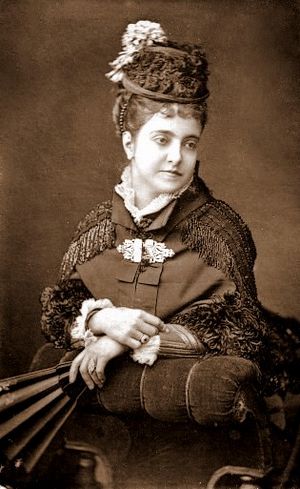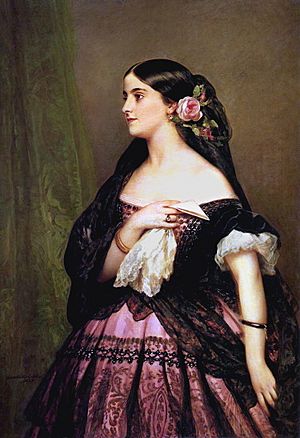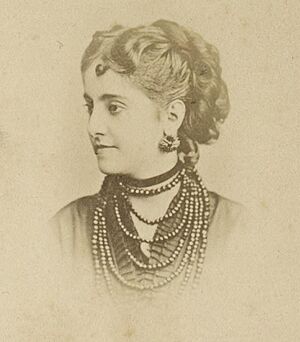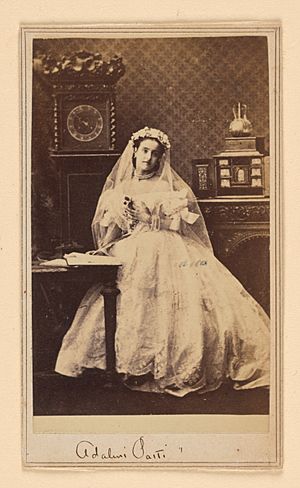Adelina Patti facts for kids
Quick facts for kids
Adelina Patti
|
|
|---|---|
 |
|
| Born |
Adelina Juana Maria Patti
19 February 1843 Madrid, Spain
|
| Died | 27 September 1919 (aged 76) Craig-y-Nos Castle, Wales, UK
|
| Occupation | Lyric coloratura soprano |
|
Label(s)
|
Gramophone and Typewriter Company |
| Spouse(s) | Henri de Roger de Cahusac Ernesto Nicolini Rolf Cederström |
| Relatives | Carlotta Patti (sister) Effie Germon (sister-in-law) Patti LuPone (great-great niece) |
| Signature | |
 |
|
Adelina Patti (born February 19, 1843 – died September 27, 1919) was a famous Italian opera singer from the 1800s. She earned a lot of money during her career. She sang in major cities across Europe and America.
Adelina first performed for an audience as a child in 1851. Her last public performance was in 1914. Many people consider Patti one of the most famous soprano singers ever. This is because her voice was pure and beautiful. She was also amazing at a singing style called bel canto.
The famous composer Giuseppe Verdi said in 1877 that Adelina Patti might have been the best singer who ever lived. He called her a "stupendous artist." Many music critics and people of her time also admired her talent.
Contents
Biography
Adelina Patti was born Adela Juana Maria Patti in Madrid, Spain. She was the youngest child of Salvatore Patti and Caterina Barilli. Both of her parents were also opera singers. Her Italian parents were working in Spain when she was born.
Her sisters, Amalia and Carlotta Patti, were also singers. Her brother, Carlo Patti, was a violinist. He married an actress named Effie Germon. When Adelina was a child, her family moved to New York City. She grew up in the Bronx.
Adelina started singing professionally when she was very young. She became a coloratura soprano. This means she had a very high, flexible voice. Her voice was smooth and warm. She learned how to sing and understand voice techniques from her brother-in-law, Maurice Strakosch. He was a musician and manager.
Her Amazing Voice and Career
Adelina Patti made her first opera performance at age 16. This was on November 24, 1859, in New York. She sang the main role in Lucia di Lammermoor by Gaetano Donizetti.
In 1861, when she was 18, she was invited to the Royal Opera House in London. She sang the role of Amina in La sonnambula by Vincenzo Bellini. She was so successful in London that she bought a house there. From London, she traveled and performed across Europe. She sang Amina in Paris and Vienna with great success.
During a tour in America in 1862, she sang "Home! Sweet Home!" at the White House. President Abraham Lincoln and his wife, Mary Todd Lincoln, were there. They were sad because their son Willie had recently died. The song made them cry, and they asked her to sing it again. After this, the song became very special to Adelina Patti. She often sang it at the end of her concerts.

Patti's career was full of successes. She sang in England, the United States, Russia, and South America. Audiences loved her, and critics praised her everywhere she went. Her youthful looks also made her popular on stage.
In the late 1860s and 1870s, she toured Europe and Russia many times. Her concerts in Moscow and Saint Petersburg were very popular. In Russia, she became friends with important people. These included famous musicians like Pyotr Ilyich Tchaikovsky and writers.
When she was younger, Patti had a sweet, high voice. It was perfect for roles like Zerlina and Lucia. As she got older, her lower notes became richer. This allowed her to sing more challenging parts. However, in the later part of her career, she chose to sing songs that suited her aging voice. Her concerts in the 1890s often featured popular, sentimental songs. These were sure to please her fans.
In her best years, during the 1870s and 1880s, Patti was a very adventurous singer. She was a good actress in roles that needed strong emotions. She sang parts like Gilda in Rigoletto and Violetta in La traviata. She also took on dramatic roles in operas like L'Africaine.
Many years earlier, Patti had a funny meeting with the opera composer Gioachino Rossini in Paris. Rossini loved traditional Italian singing. Patti's mentor, Strakosch, introduced her to Rossini. She was asked to sing "Una voce poco fa" from Rossini's The Barber of Seville. Strakosch had added extra fancy parts to show off her voice. Rossini asked, "What song was that?" Strakosch replied, "Your own, maestro." Rossini joked, "Oh no, that is not my song, that is Strakoschonnerie!" This was a playful way of saying it was "Strakosch's garbage."
Wealth and Later Life
At the peak of her career, Patti earned $5,000 per night in gold. Her contracts said her name had to be the biggest on all posters.
The famous opera promoter "Colonel" James Henry Mapleson remembered Patti's strong personality. He said she had a parrot trained to shout "CASH! CASH!" whenever he walked into the room.
Patti enjoyed her fame and wealth. She was also smart with her money. She invested wisely, especially after losing some money from her first marriage. Unlike some other famous singers who ended up poor, she lived a luxurious life until the end.
In 1893, Patti sang the main role in a new opera called Gabriella. She had asked the composer Emilio Pizzi to write it for her.
Ten years later, she went on one last singing tour in the United States. However, her voice had gotten weaker with age. The tour was not very successful. After that, she only sang in occasional concerts. She also performed in a small theater she built at her home, Craig-y-Nos Castle in Wales.
Her last public performance was on October 24, 1914. She sang at a Red Cross concert in London. This concert helped victims of World War I. She lived until 1919, dying of natural causes.
Recordings
The first recordings of Adelina Patti's voice were made around 1890. These were on phonograph cylinders. We don't know what songs she recorded or how many. These early recordings are now lost.
Patti made more than 30 gramophone records of songs and opera parts. She also made one spoken recording, a New Year's greeting to her third husband. These recordings were made at her Welsh home in 1905 and 1906. By then, she was in her 60s, and her voice was past its best.
Even so, her voice on these records still showed amazing purity and smoothness. This made up for her breath control being weaker. The records also show her lively personality. Her voice was surprisingly strong in the lower notes. Her trill (a quick back-and-forth between two notes) was wonderful. Her words were very clear. Overall, her recordings are charming and musical. They give us a hint of why she was so famous and earned so much money.
Patti's recordings included songs and parts from operas like Le Nozze di Figaro, Don Giovanni, Faust, and La sonnambula.
Her piano player, Landon Ronald, wrote about their first recording session. He said when the sound came from the gramophone, Patti was thrilled! She blew kisses to the machine. She kept saying, "Ah! My Lord! Now I understand why I am Patti! Oh yes! What a voice! What an artist! I understand everything!" He said her excitement was so real that it felt right for her to praise her own voice.
Thirty-two of Patti's recordings were put on CD in 1998.
Personal life
Adelina Patti was married three times. Her first marriage was in 1868 to Henri de Roger de Cahusac. This marriage ended, and they divorced in 1885. The divorce was difficult and cost her a lot of money.
She then lived with the French tenor Ernesto Nicolini for many years. After her divorce, she married him in 1886. This marriage lasted until his death.
Patti's last marriage was in 1899 to Baron Rolf Cederström. He was a handsome Swedish nobleman much younger than her. He helped her feel loved and cared for. He also became the only person to inherit her money. After her death, he married a younger woman. Their daughter, Brita Yvonne Cederström, became Patti's only heir. Adelina Patti did not have any children of her own. However, she was close to her nieces and nephews. The famous Broadway actress and singer Patti LuPone is her great-grandniece.
Patti loved billiards and became a very good player. She even made special appearances at billiard events.
In her retirement, Patti, now Baroness Cederström, lived in Wales. She bought Craig-y-Nos Castle. There, she had a special billiard table and her own small private theater. This is where she made her gramophone recordings.
Patti also paid for the Craig-y-nos railway station. In 1918, she gave the Winter Garden building from her castle to the city of Swansea. It was rebuilt and named the Patti Pavilion. She died at Craig-y-Nos. Eight months later, she was buried in Paris. She wanted to be near her father and her favorite composer, Rossini.
Voice
Adelina Patti had a warm, clear, and very flexible high soprano voice. Her voice was perfectly even. Her vocal range was wide, from a low C to a high F.
A music critic named Rodolfo Celletti described her technique. He said, "Her voice was a technical marvel. Her staccato (short, detached notes) were perfectly accurate. Her legato (smooth, connected notes) was impressively smooth and pure. She connected her voice from note to note with amazing skill. Her chromatic scale (notes moving by half steps) was sweetly beautiful. Her trill was wonderful and strong."
Accolades and homages
Adelina Patti was so famous that she was mentioned in many works of art.
- The operetta La Vie parisienne by Jacques Offenbach (1866) mentions her.
- She is also mentioned in books like Anna Karenina by Leo Tolstoy.
- The Picture of Dorian Gray by Oscar Wilde.
- The Age of Innocence by Edith Wharton.
- Nana by Émile Zola.
- Sherlock Holmes by Arthur Conan Doyle.
- The Village in the Treetops by Jules Verne.
- The song "The Deadwood Stage (Whip-Crack-Away!)" from the film Calamity Jane mentions a hat that Patti wore.
- In the 1890s, African-American singer Sissieretta Jones was called "Black Patti." Her music group was named "Black Patti's Troubadours."
- The opera The Ballad of Baby Doe by Douglas Moore also features her.
See also
 In Spanish: Adelina Patti para niños
In Spanish: Adelina Patti para niños







